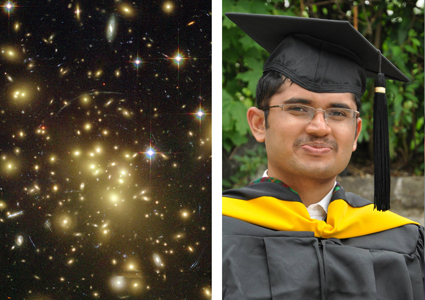First Graduate in Fall 2016: Arun Kannawadi

Gravitational lensing aims at determining the structure of the universe by observing shape distortions in very distant, faint objects, i.e., galaxies that are millions of light-years away. Such observations are important for measuring the growth of the overall cosmological structure. Moreover, weak gravitational lensing, the deflection of light by mass, is one of the best ways for us to learn about dark matter and dark energy, which constitutes one of the biggest remaining puzzles of our times.
In his Ph.D. thesis under the supervision of Prof. Rachel Mandelbaum, Dr. Kannawadi’s research focused on using image simulations to mitigate systematic errors in weak gravitational lensing measurements. Such measurements determine tiny shape distortions that occur as the light from the galaxy to Earth passes massive, yet invisible objects. These measurements are extremely difficult, as there are other sources of distortion due to the Earth’s atmosphere, telescope optics and detector defects that must be reduced or corrected. Image simulations are one of the best ways to test these correction schemes, as they can use known lensing signals to confirm that results are unbiased. Arun has worked on various aspects of weak lensing image simulations, including the input galaxy distributions, and the inclusion of defects in CCDs and infrared detectors into the simulated images. After graduation, he plans to move to the weak lensing group at Leiden (Netherlands) to carry out post-doctoral research.